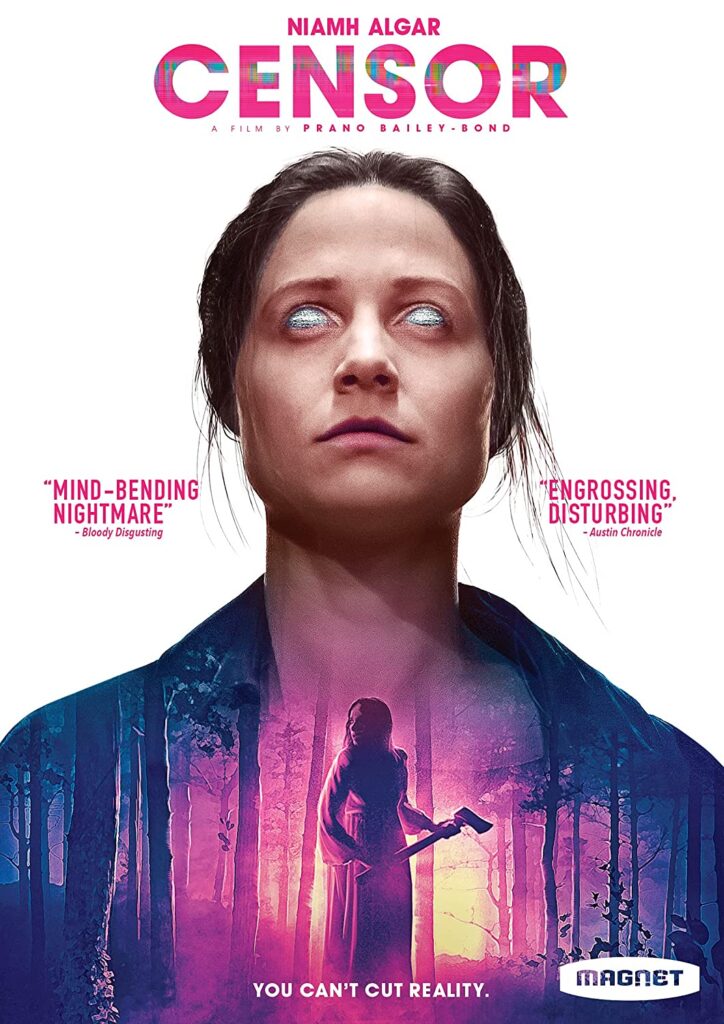
When you’re deeply unsatisfied with the job that you have, it can feel like your soul is being crushed. Especially when that job involves watching films with graphic violence day in and day out. Being forced to watch people being horrifically killed, and figuring out how much graphic content should be cut out so that these films can be released to the public, is a clear grueling task for film censor Enid (Niamh Algar).
The nature of violence in film, and how it ties into real-life violence, is a strong focal point in Censor, the feature directorial debut from director/co-writer Prano Bailey-Bond set in 1980s England when journalists and various religious groups would succumb to mass hysteria over the release of low-budget horror films and exploitation pictures with explicit content. Films otherwise known as “video nasties.” Infamous pictures including I Spit On Your Grave and Cannibal Holocaust which didn’t receive British rating certificates, resulting in them being released on VHS instead of theaters.
Initially, Censor acts as a studious horror film in the vein of Sinister where the only violence we get is in the movies Enid watches while she’s sitting in a dark, claustrophobic space. But when she’s assigned a picture starring an actress who looks suspiciously like her missing sister, Enid decides to dig deeper into the film’s production to see if that might be her and goes on a search that causes her to possibly lose her grip on reality, causing Censor to enter prosaic “psychological thriller” territory.
The hazy cinematography from DP Annika Summerson, that makes Enid feel like she’s walking her way through a dream, expertly reflects her frenetic psyche. Additionally, some of the dazzling colors bring beauty to this hideously violent picture. Meanwhile, the picture that is all about length and cutting is well-edited by Mark Towns. Thanks to Towns’ compressed editing, Enid’s mundane work routine, coupled with protesters crowding her as she walks into her office, is made to feel like an adrenaline-fueled endurance test.
As for lead actress Niamh Algar, her hollow eyes and frail appearance show a woman whose occupation is eating her from the inside out. But once Enid embarks on her mystery quest, Enid’s eyes morph from feelings of desolation to hunger and obsession for the truth. Her co-stars do fine in their supporting roles including British character actor Michael Smiley as a sleazy movie producer. Yet, it’s primarily the Algar show and she simply gives an acting masterclass.
Algar successfully navigates a movie that is slightly at war with itself with the stories it wants to tell. The ongoing debate over how much screen violence influences real-life violence is a debate worth having. However, how it connects to the storyline involving Enid and her missing sister is rather unclear. If anything, the family storyline gives Censor some sentiment even if the picture’s dissection of the frenzy which the video nasties caused during that time period is the more interesting subject.
Due to its plotline mismatch, Censor ends up being in “like” territory rather than “love.” However, its brash ambition, and how it’s like a nostalgic fever dream, is undeniable. Plus, Prano Bailey-Bond’s attempt to dissect audience perception of horror movies within that time period, while showcasing genre mechanics, is a rather commendable one.